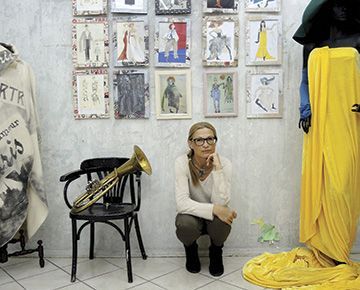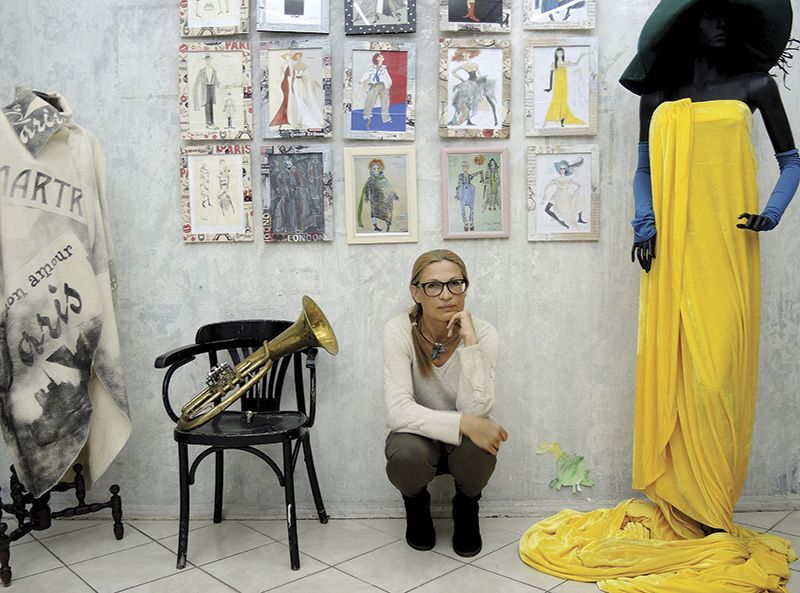
Тatiana’s costumes for performance characters are usually stylish. They are bright and always memorable. With a whiff of modernity, irrespective of what era they depict, Tatiana obligatorily invents details in her costumes which describe the characters they are intended for and influence the performance in general. She admits, it matters little what costumes are used in a show but how well they are matched to it. A costumier is always backstage; although their name is mentioned on posters few people are truly interested in who created the dresses for the performers.
Last year, Ms. Lisavenko celebrated a special anniversary; with this in mind, she decided to sum up her experience by organising a personal exhibition of her sketches — hosted by the gallery of the Designers’ Union. Many actor-friends attended the show and among the guests were also the key personalities who’d played a major role in Tatiana’s career. The party was warm and friendly and the guests full of praise for their host and her work. Ms. Lisavenko recollects the day with great pleasure.
Tatiana, what are your feelings looking at the reaction to the show?
I experienced real feelings of satisfaction. It was nice to hear praise and appreciation of my work of course. My life is in my sketches, I love my work and it was a great pleasure to me that my joy was shared by my friends and the people I respect and love: Boris Lutsenko, Olga Klebanovich, Bella Masumyan, Valentina and Alexey Yerenkovs, as well as my favourite actors, colleagues and directors. Stage directors also attended; among them were Yevgeny Volkov and Veniamin Marshak whom I view as my teachers.
Were all your sketches represented at the show?
Only half of them were shown. Each performance and its costumes create a separate story. Some sketches are put aside and new ones are created. Even I was shocked at how many there were! When I sat down and looked at them all and decided what should be in the exhibition it was a hard decision. Eventually, I chose sixty sketches but around the same number have been put aside for now.
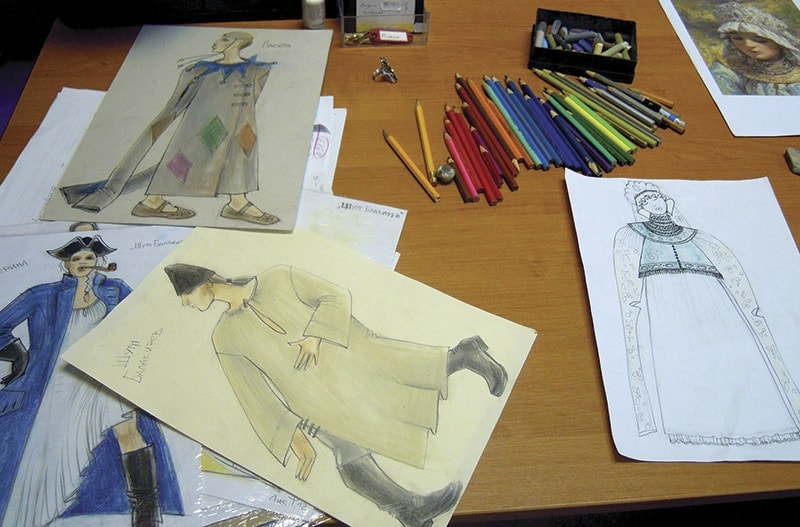
What was your pathway to the world of costumes in Belarusian theatre?
I didn’t take the usual route into the profession but joined the theatrical sphere by chance. I’m a fashion designer by profession; after graduating from Vitebsk Technological University, I worked on my specialism at Alesya Knitwear Factory. I had joined the factory as a fashion designer as there was no other vacancy available (although my diploma was as a fabric artist and I loved to work with interiors). I realise now that this was a risk but I’m always curious about new opportunities. This feature of my character often inspires me to accumulate new experiences and experiment with new ideas. The theatrical world was not entirely new to me: my friends, the Shilov couple, work at the Young Spectator’s Theatre. Volodya is known as one of the best theatrical props designers in the country. Naturally, I often attended her premieres and was even occasionally allowed backstage.
Were you already aware of the backstage life then?
Yes — to a certain extent. I loved the theatre I knew; I loved people who worked there. My work with costume began with a People’s Artist of Belarus — Boris Lutsenko; he was at that time the chief director of the National Academic Drama Theatre named after Maxim Gorky. He was preparing to stage Molière’s ‘Amphitryon’ and wanted to invite a fashion designer to help with his costume. The chief artist of the Russian Theatre, Yevgeny Volkov, recommended me, as we knew each other well. I took a risk once again owing to my curiosity, thinking more about the opportunity rather than my chances of success. The work was not difficult, I found it enjoyable and the brief was clear although I worked on the whole collection using mostly my intuition. I was well supervised by Yevgeny and everything turned out to be a success in the end, which was the beginning of my love affair with this wonderful profession.
When did you realise that you’d made the right choice?
I realised this immediately after ‘Amphitryon’. I was on a high after the show, I’d loved every minute of it, including the people involved in the theatre, whom I really admired. I was in awe of everything and everyone I met. After the premiere — which was a success, Boris invited the production team onto the stage, including me. For the first time in my life, I experienced the energy of the crowded hall. For around two weeks afterwards I felt as if I was walking on air, I’ve tried and failed to recapture the feeling many times since. It was a powerful moment which, figuratively speaking, connected me to the theatre and my work as a costumier. At that time, I wasn’t really interested in the salary as I was so captivated by my feelings and my enjoyment of the theatre!
Have you felt the same after other shows, when coming onto the stage at the end?
Sadly, no, I haven’t felt the same feelings since — although many of my costumes were acknowledged as successful and I was also extremely satisfied with my work. In the course of time, I realised that theatre folk are the same as other people. They are not gods. Moreover, an artist’s work can also be routine — which is normal.
What about Аlesya?
Until recently, I managed to combine my work as a costumier with the development of a collection of clothes for the company. At the moment, I’m a freelancer.
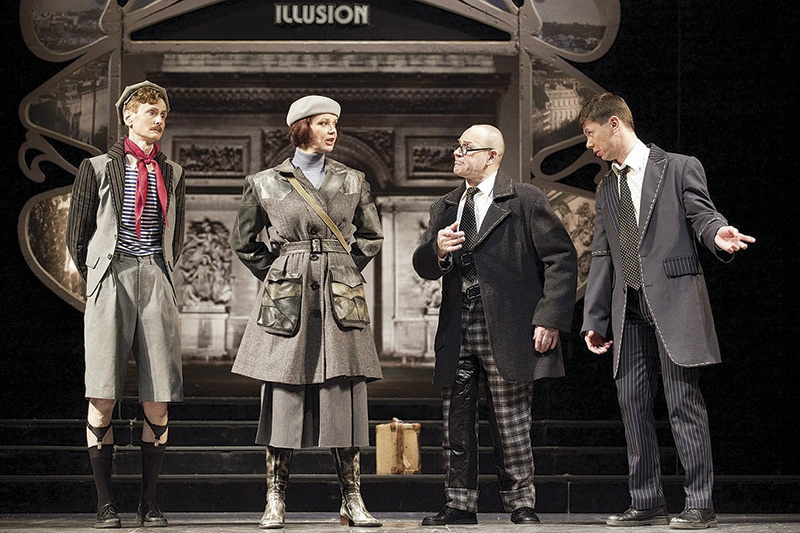
What do you need to achieve success in working with costumes?
First of all, it’s necessary to be on the same wavelength with a director and a set designer. It is important not only to understand them but also share their vision. If this happens, then you are on their team. The greatest number of performances with my costumes is at the National Academic Drama Theatre named after Maxim Gorky. At present, its repertoire includes 8 productions for which I designed costumes. Among them is ‘The Taming of the Shrew’; in 2016, it will celebrate its 10th jubilee. In turn, my debut show ‘Amphitryon’ was staged for over 12 years. Some directors are prescriptive about their needs, some provided me complete freedom and then listened to my suggestions. Sometimes we immediately understood each other and the process of work was fast. Sometimes it lasted for months. I was mostly lucky and I always found a common language with the directors.
Even during the rehearsals, the costumes are subject to change. Actors can sometimes have opinions on how their character should look and we have to negotiate our shared vision. In the play ‘Oh Dad, Poor Dad…’ by Arthur Kopit, directed by Valentina Yerenkova — an Honoured Artiste of Belarus — Madame Rosepettle — played by Olga Klebanovich — had a white mask with broad white clay stripes on her head. She was initially unhappy with it but then said, “If you come to every performance and do it for me, I will agree.” It was a pleasure for me to do this.
What personal characteristics does a costumier need to achieve success?
Definitely, professionalism — which comes with experience — is a must. However, intuition is also needed. It’s possible to make good costumes which would meet the approval of the artistic council. However, these would not ‘perform’ as needed if an artist fails to fill them with their own soul and feelings. There would not be much satisfaction for the artist either.
Should a play impress you?
Not necessarily. In some cases, a play did not impress me itself but I was inspired to work on it. It’s important to find a thread which would connect you with a drama and to see the characters in role. Of course, when I enjoy a play then the sketches are made with true enthusiasm. This happened during my work with Gogol’s ‘Grooms’ — staged by Ms. Yerenkova. Another similar show was ‘The Colonel and Birds’ — staged at Mogilev Drama Theatre by Vladimir Petrovich.
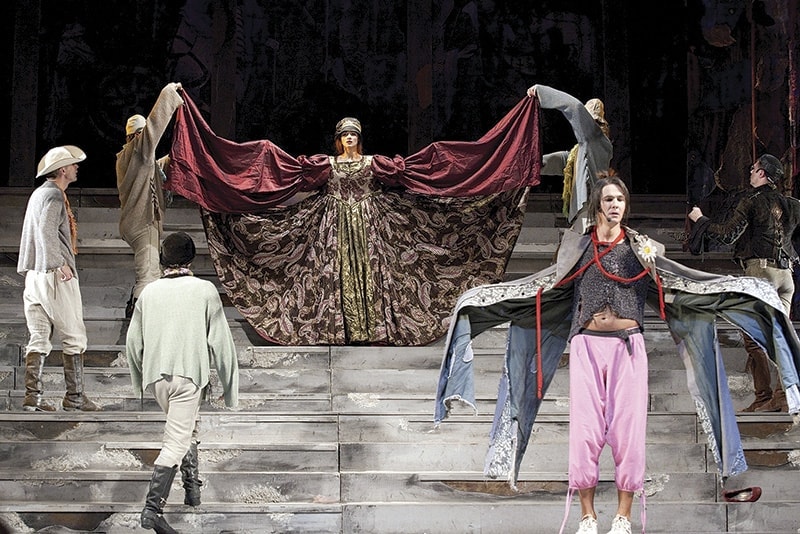
What are your inspirations?
In our modern times, it is the whole world and the Universe. Of course, these are also travel, books and communication with others. The Internet also cuts the time spent finding out information. The process inspires me. I once needed to find an image of a blind man who was the main character of ‘Alpine Glow’. I was driving to work and, in the Nemiga area, saw a man; homeless but looking colourful. He became the prototype for the design.
Some think that an artiste and an actor should enjoy personal empathy. Can you comment?
I can tell you a story from our work on ‘Amphitryon’. Boris Lutsenko invited me and said that I should work on making one rather large actress look impressive and beautiful. I was anxious about the meeting and when the actress Olga Klebanovich arrived I was taken aback, realising she wears a size 48, which is not the largest I was expecting. Her costume proved to be a success, Olga looked wonderful, she felt comfortable in the dress I designed. Since then, we have trust and sympathy for each other. It is important for a costume to be accepted by the actor. I must say, I loved to design clothes for large people as I like to break down stereotypes.
When other actresses begin demonstrating trust?
It took me some time to win the respect of some other actresses. Women are often complicated and they all want to look beautiful on the stage. I understand this and try to design clothes which would make them feel their best.
How do you treat criticism?
In my youth I was easily offended, but I’m much better at accepting criticism now. I was once accused of having bad taste as I designed a costume of bright pink flowers with green for my character. I love to break the rules and cause a bit of controversy. I like to take risks especially with colours. Artists treat the colour gold with great caution but I once used gold, green and pink colours for a costume as an experiment. Olga Klebanovich’s dresses in ‘Circle of Love’ (by Maugham) were also criticised; some were of the opinion that they were too extravagant. I stick by my design as the character of Kitty will remain in my memory for a long time. Such vibrant personalities as Ms. Klebanovich and her Kitty need bright and flashy costumes. The highest praise for me is the audience’s reaction and Olga’s opinion of course.
What happens when a director disagrees with your idea of a costume?
There are issues which are exclusively under the director’s supervision. I should never interfere in their territory. If a director doesn’t like my idea, I research further and think of something else.
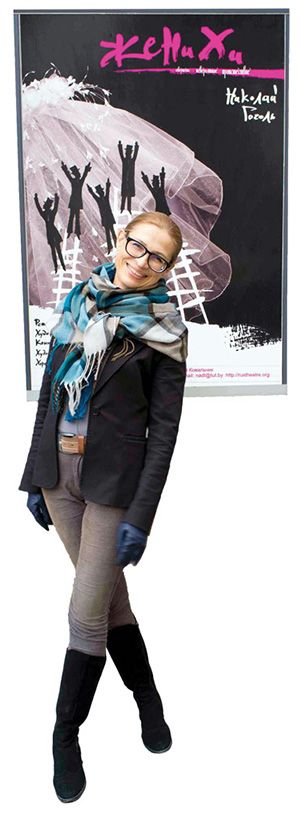 What’s the hardest aspect of your work as a designer?
What’s the hardest aspect of your work as a designer?
For me, a director’s opinion at the first fitting is important. As a rule, I invite them as I believe that the final result will be better if they’re involved from the start and they are a valuable link between myself and the actor. It’s important for a costume to be approved at the first fitting to avoid any changes in the future. It is a tense moment but the most difficult part for me is when the actors come out in their costumes on stage. As a rule, there are no lights and decorations. A costume might ‘collapse’ as a result. I worked on ‘Vado per Vedove’ — staged by Vitas Grigaliūnas; Samuil Marshak was responsible for the scenery. When the actors appeared on the stage, I almost fainted: the costumes did not ‘work’ and looked terrible. The scenery was working against my costumes and overwhelming them. I was terribly upset. Mr. Marshak was not present at the rehearsal so I called him to explain my thoughts that there was no unity of scenery and costumes... He calmed me down — saying that everything would be okay. When the lighting was set up and some details of the scenery were shadowed the costumes worked much better. Over the course of time, I have learned not to panic and stay calm when such crucial moments occur.
Have you ever had to work quickly over a costume?
There have been plenty of times where I’ve even had to come to a meeting with a director with sketches ready… and they were approved immediately. I had an interesting experience when I was working on ‘Uncle’s Dream’. I had only one month to complete my work while Dostoevsky’s play was full of hoop skirts, bows and lace — which were natural for the 19th century. I love working under pressure though, I met the set director Alexander Kostyuchenko who showed me a draft. I then talked to the director, Modest Abramov. The sketches were put to work after our third meeting. Mr. Abramov set out the brief clearly — saying that the costumes should show the different colours of an artist’s palette. In turn, Mr. Marshak (to whom I’m very grateful) advised me to play with the structure of cloths. I followed his recommendations — moving the focus point of each outfit. The result was interesting: on the one hand, the costumes reflected the epoch but, on the other hand, different cloth structures made them light and ‘alive’.
What characters inspire you? What era is most interesting?
It’s easier to make costumed performances from the past. I also love stylised pieces. It’s much more challenging for me to work with modern shows, the design is difficult to envisage initially particularly for the theatre where impact needs to be made through the costume. I experienced a similar situation with costumes for ‘Ninochka’. When Boris Lutsenko saw my sketches he was not impressed with the outcomes and, after the disappointment, we had to work together to create around a hundred sketches until the final ideas were acceptable and the final costumes for the characters in ‘Ninochka’ were chosen.
Is it necessary to be able to sew to make costumes? Do you personally sew?
I did used to work on the sewing myself many years ago but I don’t sew now. I don’t think a designer should necessarily sew themselves but should be able to understand the art of fit and be aware of a seamstress’ work.
What is your personal style?
A clothes designer probably comes to the fore. Many costumes belonging to my characters could have lived their own lives and been used for a catwalk. I’ll probably prepare a catwalk show of my costumes for my next anniversary.
Who are your favourite designers?
In the world of fashion, I love John Galliano as a personality owing to his theatrical and historical costumes. His catwalk events are always true shows. Clothes I’d love to buy would be anything designed by Donna Karan.
By Valentina Zhdanovich









